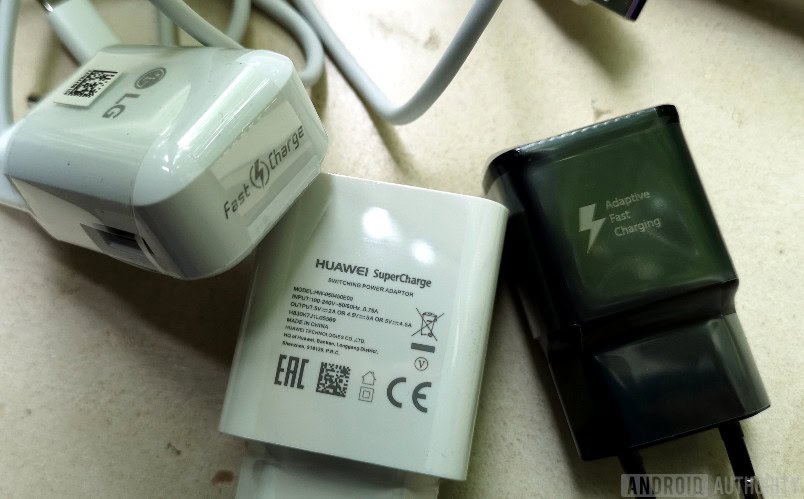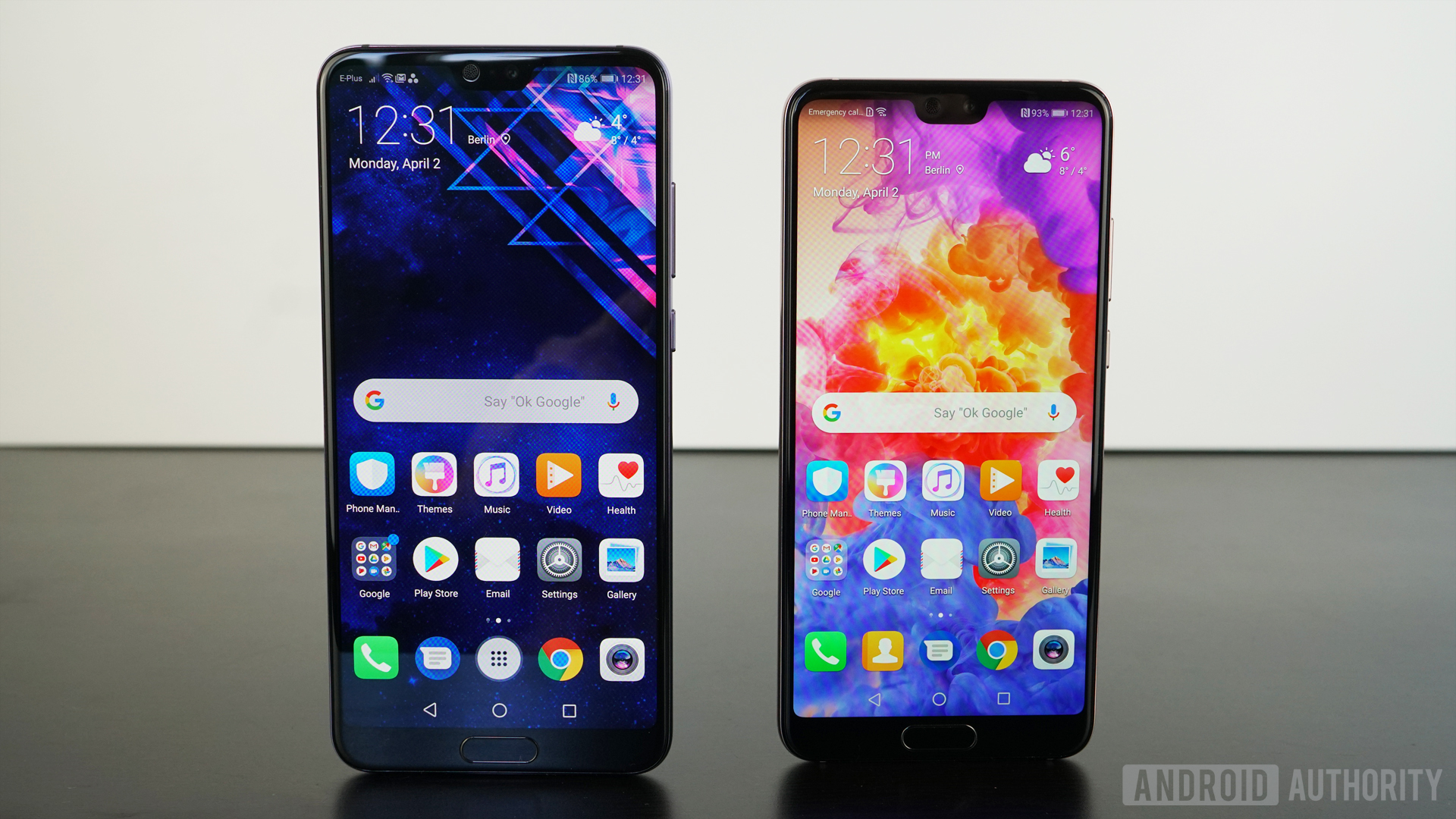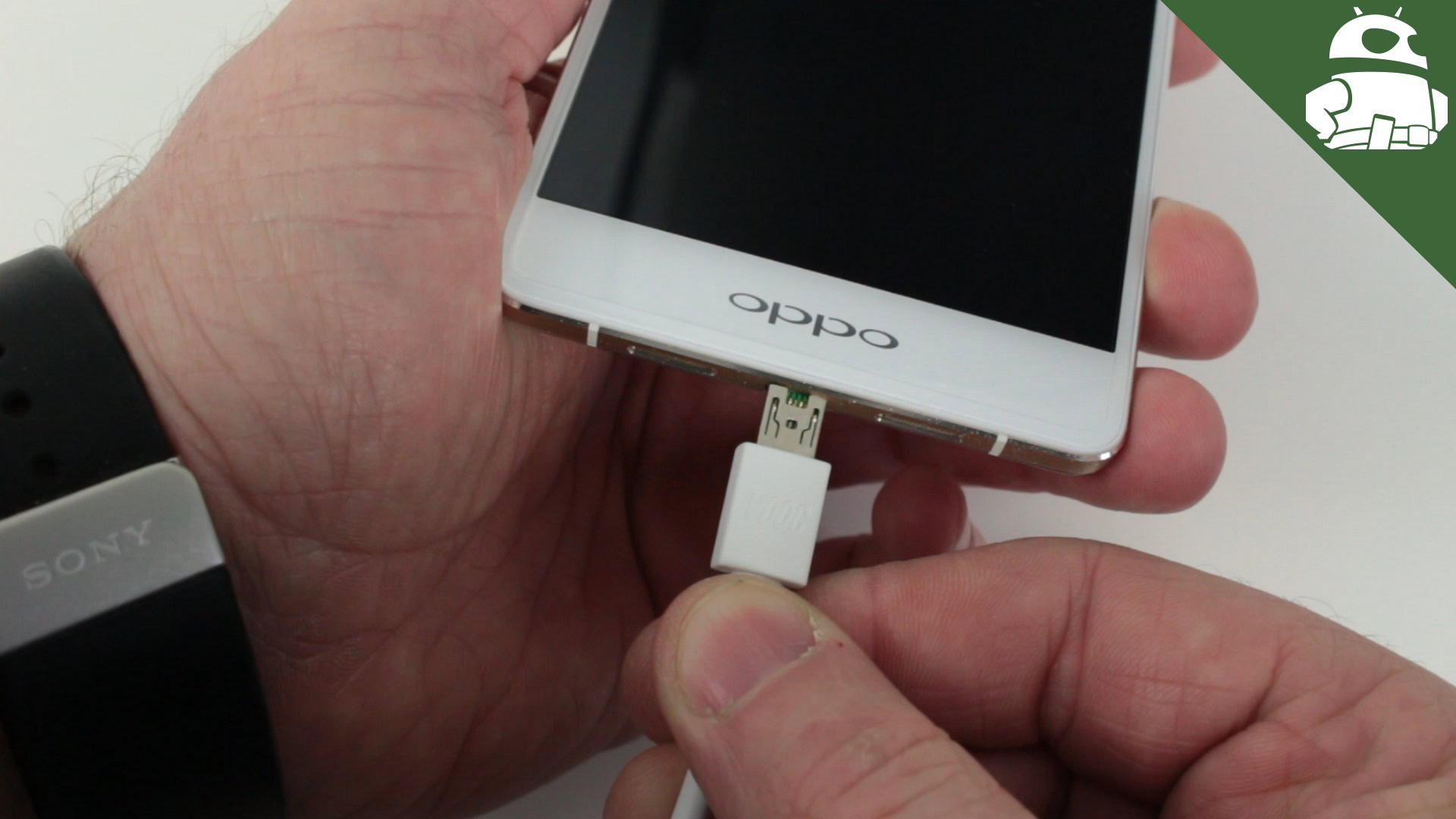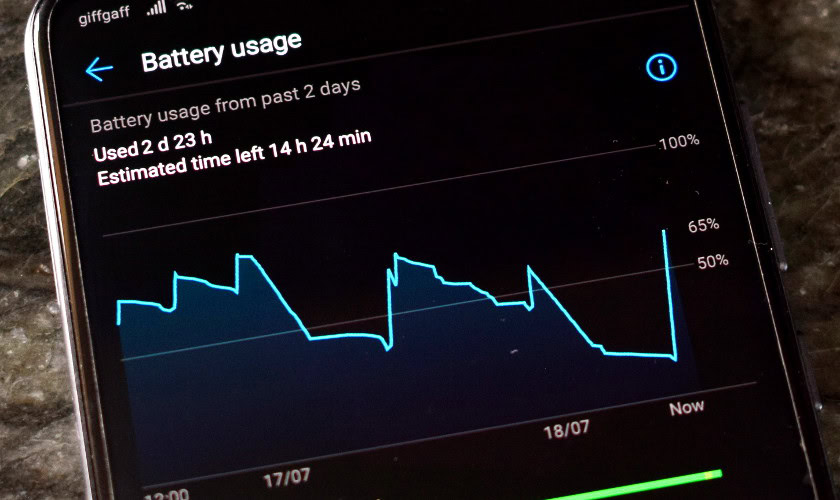
Fast charging is a must have feature in today's phones. It keeps our batteries topped up through busy days. However, there are a variety of different standards from different companies. Some only work with specific cables and chargers, while others use higher voltages. It can all get a bit confusing, so we're here to make sense of it.
In a nutshell, fast charging increases the current sent to the battery to fill up its capacity quicker. The basic USB specification only sends 0.5 amps (A) of current using 5 volts (V) for just 2.5 watts (W). Fast charging technologies boost these figures. Huawei's 5V/5A SuperCharge produces 25W and Samsung's 9V/1.7A Adaptive Fast Charging produces 15W of juice. All fast charging services share a — more power.
That's just the basic overview. How a battery actually charges up is more complicated. Before we get to that, let's look at the differences between all of these fast charging standards in more detail.
Fast charging standards explained
USB Power Delivery
USB Power Delivery (USB-PD) is the official fast charging specification published by the USB-IF back in 2012. The standard can be used by any device with a USB port, provided its manufacturer includes the necessary circuitry and software. Just like all fast charging standards, USB-PD implements a data protocol to communicate between the charger and phone. This negotiates the maximum tolerable power delivery for both the charger and handset.
USB Power Delivery augments the basic USB charging speeds for up to 100W of output power. The amount of available power is split into different power ratings, which operate at different voltages. The 7.5W+ and 15W+ modes are best for phones, while 27W and above are for laptops and other higher power devices. The standard also supports bi-directional power, enabling your phone to charge other peripherals.
| Power output (Operating Voltage and Current) | 0.5 - 15W | 15 - 27W | 27 - 45W | 45 - 60W | 60 - 100W |
|---|---|---|---|---|---|
| 5V | 0.1 – 3.0A | 3.0A (15W cap) | 3.0A (15W cap) | 3.0A (15W cap) | 3.0A (15W cap) |
| 9V | 1.67 – 3.0A | 3.0A (27W cap) | 3.0A (27W cap) | 3.0A (27W cap) | |
| 15V | 1.8 – 3.0A | 3.0A (45W cap) | 3.0A (45W cap) | ||
| 20V | 2.25 – 3.0A | 3.0 – 5.0A |
Google's Pixel series utilizes the official Power Delivery specification. Apple also implements the standard in the iPhone 8, iPhone X, and latest MacBooks. Many companies prefer their own proprietary charging standards.
Qualcomm Quick Charge
Qualcomm's proprietary Quick Charge technology was once the default standard in the smartphone industry, as it popularized fast charging before USB Power Delivery. The latest 4.0+ revision of Quick Charge is compatible with Power Delivery, allowing for faster-charging speeds and a wider range of support.
| Voltages | Max Current | Max Power | |
|---|---|---|---|
| Quick Charge 1.0 | 5V | 2A | 10W |
| Quick Charge 2.0 | 5 / 9 / 12V | 3A | 18W |
| Quick Charge 3.0 | 3.6 - 20V (200mV increments | 2.5 / 4.6A | 18W |
| Quick Charge 4.0+ | 3.6 - 20V (200mV increments) QC Mode 5 / 9V USB-PD Mode | 2.5 / 4.6A QC Mode 3A USB-PD Mode | 18W QC Mode 27W USB-PD Mode |
Quick Charge is an optional feature available with Qualcomm's Snapdragon processors. So just because a phone has a Qualcomm chip doesn't mean it is Quick Charge compatible. Even so, a wide range of phones boast Quick Charge support, including the LG V30, LG G7, Samsung Galaxy Note 8, HTC U12 Plus, and many more. There's also a broad ecosystem of legacy chargers and third-party accessories out there, due to the standard's popularity.

Other standards
In the smartphone ecosystem, many models use in-house technologies rather than the more ubiquitous standards above. However, only a few of these standards are truly proprietary. Many are just Power Delivery or Quick Charge repackaged under a different brand name, or featuring some specific tweaks to the technology — Samsung's Adaptive Charging and Motorola's Turbo Charging technologies come to mind.
Others like Oppo's VOOC and Huawei's SuperCharge operate quite differently. These greatly increase the amount of current for high power charging rather than increasing the voltage. Here is how some of the most common technologies stack up side by side.
| Charging Technology | USB 2.0 port | USB 3.0 port | Samsung Adaptive Fast Charger | OnePlus DashCharge / Oppo VOOC | Huawei SuperCharge | MediaTek PumpExpress 4.0 (USB-PD) | Motorola TurboPower 30 (USB-PD) |
|---|---|---|---|---|---|---|---|
| Max Power | 2.5W | 7.5W | 15W | 20 / 25W | 25W | ~25W | 28.5W |
| Voltage | 5V | 5V | 5V / 9V | 5V | 5V | 3V - 6V (10-20mV per step) | 5 / 9 / 12V |
| Current | 0.5A | 0.9 / 1.5A | 2 / 1.67A | 4 / 5A | 2 / 4.5 / 5A | 5A | 5.7 / 2.85 / 2.15A |
It is possible to support multiple standards or at least ensure some level of compatibility with different fast charging methods. Unfortunately, this leads to a lot of unpredictability about the exact charging speeds you'll receive when using phones with different chargers and even different cables.
After testing several phones, we found a wide variation in how much power each phone negotiated, depending on the charger and cable used. The best results are typically achieved by using the cable and charger supplied in the box with your handset.
How to fast charge a Lithium-ion battery
Now that we've covered the standards, let's delve into how fast charging actually speeds up a battery's charging cycle. Lithium-ion batteries used inside smartphones and other electronic gadgets don't charge in a linear fashion. The charging cycle is broken into two distinct phases.
The first is the increasing voltage, or constant current phase. The battery voltage steadily increases from as low as 2V up to its peak of around 4.2V as it charges up. This varies depending on the exact battery. The battery draws the highest peak current during this phase, which remains constant until the battery voltage peaks.
The voltage then becomes constant and the current begins to fall. Batteries that charge beyond this point draw less current and therefore charge slower. This is why the first 50 or 60 percent of your phone charges considerably faster.

Battery University Battery charging occurs in two phases. Rising voltage/constant current and constant voltage/falling current. The first phase is suitable for high-current fast charging.
Fast charging technologies exploit the constant current phase. Pumping as much current as possible into the battery before it reaches its peak voltage. Therefore, fast charging technologies are most effective when your battery is less than 50 percent full, but have little to no effect as you pass 80 percent. Incidentally, constant current charging is the least detrimental period to the battery's long-term health. Higher constant voltage, along with heat, is detrimental to battery life.
Finally, the amount of voltage and current passed to the battery is controlled via a charge controller circuit inside the phone. Coupled with temperature and voltage sensors, the controller can manage the amount of current to optimize the battery's charge speed and long-term health.
Fast charging at high voltage?
Some of you may have spotted an apparent issue here. If lithium-ion batteries have a typical voltage around 3 to 4.2V, isn't it dangerous to use higher voltage chargers?
Ordinarily this would be the case, but smartphone circuits step voltage down and current up. This keeps the amount of power transferred the same (P = IV), but moves the voltage into the correct range. And no, fast charging cables don't do AC voltage conversion. If you look on the back of the charger, you'll be able to spot the little dashed DC current icon ⎓. USB is always a DC power delivery system.
High voltage fast charging circuits use a switch-mode step-down power supply, also known as a buck inverter. This circuit takes a high DC voltage and converts it down to a lower DC voltage. Ideally, it also multiplies the current by the inverse amount thanks to its "charge pump" characteristics. It's essentially a switch toggling the input voltage to charge up a capacitor with lots of current.

Analog This looks complicated, but follow the graphs on the right. The high input voltage switches on and off to create a PWM signal from Vin. This induces a high "pumping" current through the inductor L into capacitor Cout. At the load (battery) we see a high current and low average voltage (Vout).
Stepping down from 10V/1A to 5V ideally yields 2A current after the converter. In the real world, there is always some loss associated with these conversions (typically these are above 90 percent efficient), dissipated as heat. Switch-mode power supplies also typically waste less energy than a linear regulator.
Why use higher voltages?
There are two main reasons to use higher voltages. First, switch-mode power supplies are more efficient than linear regulators which decrease voltages via heat dissipation. This is especially important for keeping our phones and their batteries cool.
The second relates to power loss over USB cables, particularly longer ones. A resistor, such as a length of wire, drops a voltage based on the current passing through it (Ohm's law V=IR). Transmitting the same power using a higher voltage and lower current loses less of power over the length of the cable. This is more efficient and why the main power grid is hundreds of volts and not 5V.
However, the trade-off is that buck converters are more readily current-limited than linear regulators. The maximum output power depends on the inductor size, capacitor and voltage ripple, as well as the switching frequency, in addition to the power capabilities of the transistors. It's only possible to reach very high currents via a more traditional linear voltage regulator. This is why some of the low voltage 5V fast charging technologies, like those from Huawei and OPPO, offer more total power than higher voltage buck-switching versions from Qualcomm and Samsung.

MediaTek MediaTek's latest Pump Express technology caters to both switch mode and linear regulator charging.
The diagram above shows how MediaTek's PumpExpress 3.0 and 4.0 manage to reach up to 5A of charging current. If a 5A cable is connected, its technology bypasses the conventional switching charger to enable a higher current. In this case, the circuit negotiates the required voltage over the data lines, raising and lowering the Vbus charging voltage for maximum efficiency.

Wrap up
Fast charging encompasses a range of different possible technologies, each with their own pros and cons. This is partly why there are so many different standards on the market, as companies take their own approaches to speed up charging and maximize battery longevity.
A few generations ago, high voltage charging was becoming the norm and now technologies are implementing lower controlled voltages and high currents to boost speeds even further. However, this necessitates thicker cables and adds another compatibility headache.
USB Power Delivery is already pretty widely adopted. It will likely form the backbone of all USB charging standards going forward, though we will likely see companies experiment with their own even faster solutions on top of supporting this universal standard.
Next: Charging habits to maximize battery life
from Android Authority https://ift.tt/2AkQjI4
via IFTTT




Aucun commentaire:
Enregistrer un commentaire